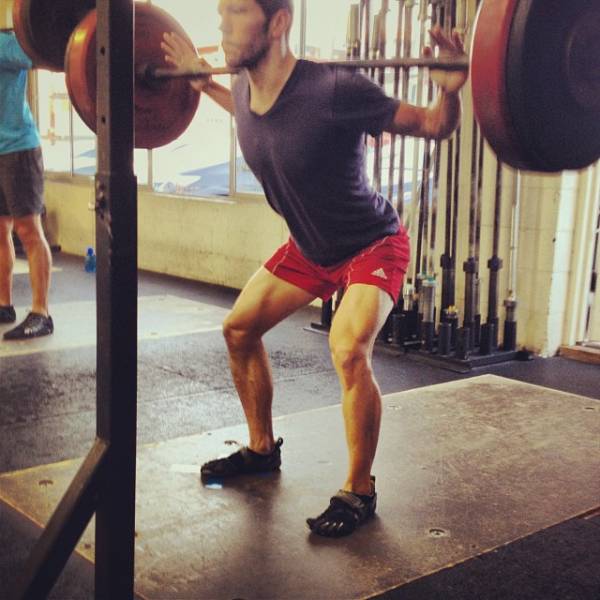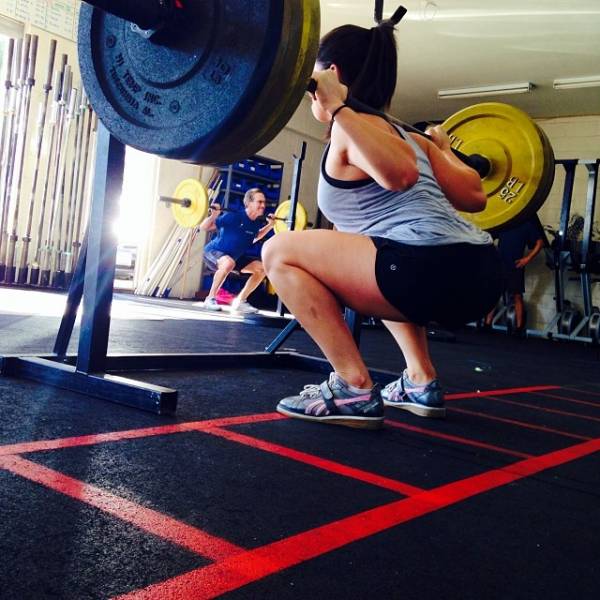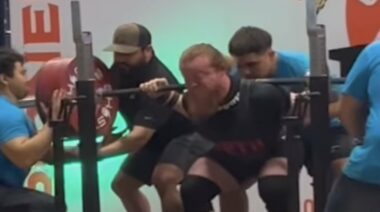So, you want to squat more weight, but you already have your lifestyle pretty much dialed in, particularly food, sleep, rest, and recovery. (If you don’t, what are you doing reading an article on how to squat more when the answer is right there? Go sort that sh*t out.) You are on point with everything, your programming is progressive, and you are hungry for the gains. If this is you and you want to squat more, then perhaps the answers lie at the bar itself. (No, not that kind of bar. Although rumour has it there’s a few answers to be found there too.) If you are not approaching and addressing the barbell correctly, you are leaving valuable kilos on the table.
Here are eight ways you can increase your squat without getting any stronger. Believe me, you already have the strength. It’s simply a case of learning how to tap into it. These are direct changes that can have a quick and profound impact on how much you lift.
1. Approach the Bar in the Same Way
The first aspect to pay attention to regarding how you step up to the bar is, well, how you step up to the bar. Watch any successful lifters in any sport and you will see they approach the bar in exactly the same way every time. This gets your body set and your mind focused and away from the fact that the weight on the bar is any more or less, as the set-up is exactly the same every time. Become consistent at approaching the bar consistently.
2. Approach the Bar with Belief
When you approach that bar, there needs to be no doubt in your mind that you are going to make the lift. I see so many lifts fail due to a simple lack of confidence, which then starts screwing with your hip path, speed of descent, or your nerve to get up out of the hole. To help with this, use visualization techniques. Your mind doesn’t know the difference between what you’ve actually done before and what you convince yourself you’ve successfully done before. And if your mind feels like you’ve done it before, it feels better about allowing you to do it “again.” But you need to be approaching the bar with belief before it gets to that. Every time, in fact.
3. Get Tight Before Lifting the Bar
Let’s get this one clear – you need to create maximum tension before you lift the bar off the rack, not after you have done so. Once you have the bar on your shoulders, it is too late. Never mind the fact you took the bar off the rack in too soft a position anyway (more on that in a minute). Once you have the bar on your back, there’s no way you are going to be able to create the same amount of tension and extension as when you had nothing on your back to fight against. Take your time to get yourself super tight just before you get under that bar – then all you need to do is maintain it.
4. Be Aggressive When Unracking the Bar
So, you’re becoming consistent with your approach and positive belief, and you’ve created a ton of tension. You’re now ready to lift. You get under the bar, pop it off the rack, and take a few steps back. You are now ready to go right? WRONG. As we’ve already seen with your positive approach to the bar, the aggression starts way before the point where you’re in the hole and need to drive up. Wedge yourself hard underneath that bar, and power that thing off the rack like you mean business. (I’m assuming you do.) Then take two, and only two steps back. Each step back is like a miniature one-legged squat, and why would you want to do that just before you squat? Shouting, growling, or roaring as you unrack the bar like a beast is particularly effective, plus tends to keep people out of your way.
5. Breathe Hard
 Now that you have the bar on your back, breathe hard to create some serious pressure. If you’re wearing a belt, breathe hard into it. This doesn’t mean a breath into your chest. This is the opposite of a breath that makes you puff up your chest and look more attractive. This is a breath that pushes your stomach out and makes you look like you ate all the pies. If you’re reading this and that bothers you, you might as well stop reading now. You’re not hungry enough for it (maybe because you actually ate all the pies). This isn’t a small inhalation of air. You should be trying to deprive the rest of the room of oxygen. And why on earth would you start your squat before you have finished taking a breath? Stop, quite literally, paying lip service to breathing. It is arguably the most important point on this list. And it is a skill. Get better at it.
Now that you have the bar on your back, breathe hard to create some serious pressure. If you’re wearing a belt, breathe hard into it. This doesn’t mean a breath into your chest. This is the opposite of a breath that makes you puff up your chest and look more attractive. This is a breath that pushes your stomach out and makes you look like you ate all the pies. If you’re reading this and that bothers you, you might as well stop reading now. You’re not hungry enough for it (maybe because you actually ate all the pies). This isn’t a small inhalation of air. You should be trying to deprive the rest of the room of oxygen. And why on earth would you start your squat before you have finished taking a breath? Stop, quite literally, paying lip service to breathing. It is arguably the most important point on this list. And it is a skill. Get better at it.
6. Keep Your Head Still
Focus on a point in front of you. Stay focused on that point throughout the whole damn lift. This will help to keep you focused, keep your body in a good position, and keep you safe. It’s quite important when you look at it like that, isn’t it? If you have people walking directly in front of you when you squat, firstly you didn’t growl loud enough when you took the bar off the rack, and secondly they need to learn (perhaps you need to teach them) some simple manners and lifting etiquette. Keep your head still throughout the whole lift. And if I am coaching you, do not turn to me until after you have racked the bar.
7. Control the Descent
This is perhaps the question I get asked the most (well, apart from the one about weightlifting shoes). The question is usually some variation of “how slow should I make the descent down to the bottom of the squat?” My answer is “as slow as you need to, to maintain tension and control.” Too fast and you will lose a lot of the good stuff you have worked so hard to create over the first five points. You will end up with little left to come up out of the bottom of the squat with. Too slow and you will waste valuable energy getting down into position. I’m always telling people to slow down their descent, but if you are able to maintain tension and control, then you have my permission to speed it up a bit.
8. Drive Out of the Hole With Speed
 Before you ask, here’s the answer – “slow down, fast up.” The powerlifts are sometimes called the slow lifts, but as far as I am concerned that is a misnomer. You should always be trying to impart speed on the bar on the way up. Every single time. Whether you actually manage to make the bar move quickly is another story, but you should be trying. This applies to maximum effort days, as well as your speed work. The benefits of creating this speed are numerous, but in terms of direct application to how much you squat, consider that a fast drive up from the bottom of the squat is more likely to get you through sticking points and thus, in the long run, be less of a toll on the body than slow, grinding efforts that are pulling you out of position. More weight, more successful lifts, and fewer injuries – sounds like a winning combination to me.
Before you ask, here’s the answer – “slow down, fast up.” The powerlifts are sometimes called the slow lifts, but as far as I am concerned that is a misnomer. You should always be trying to impart speed on the bar on the way up. Every single time. Whether you actually manage to make the bar move quickly is another story, but you should be trying. This applies to maximum effort days, as well as your speed work. The benefits of creating this speed are numerous, but in terms of direct application to how much you squat, consider that a fast drive up from the bottom of the squat is more likely to get you through sticking points and thus, in the long run, be less of a toll on the body than slow, grinding efforts that are pulling you out of position. More weight, more successful lifts, and fewer injuries – sounds like a winning combination to me.
Photos provided by CrossFit LA.






